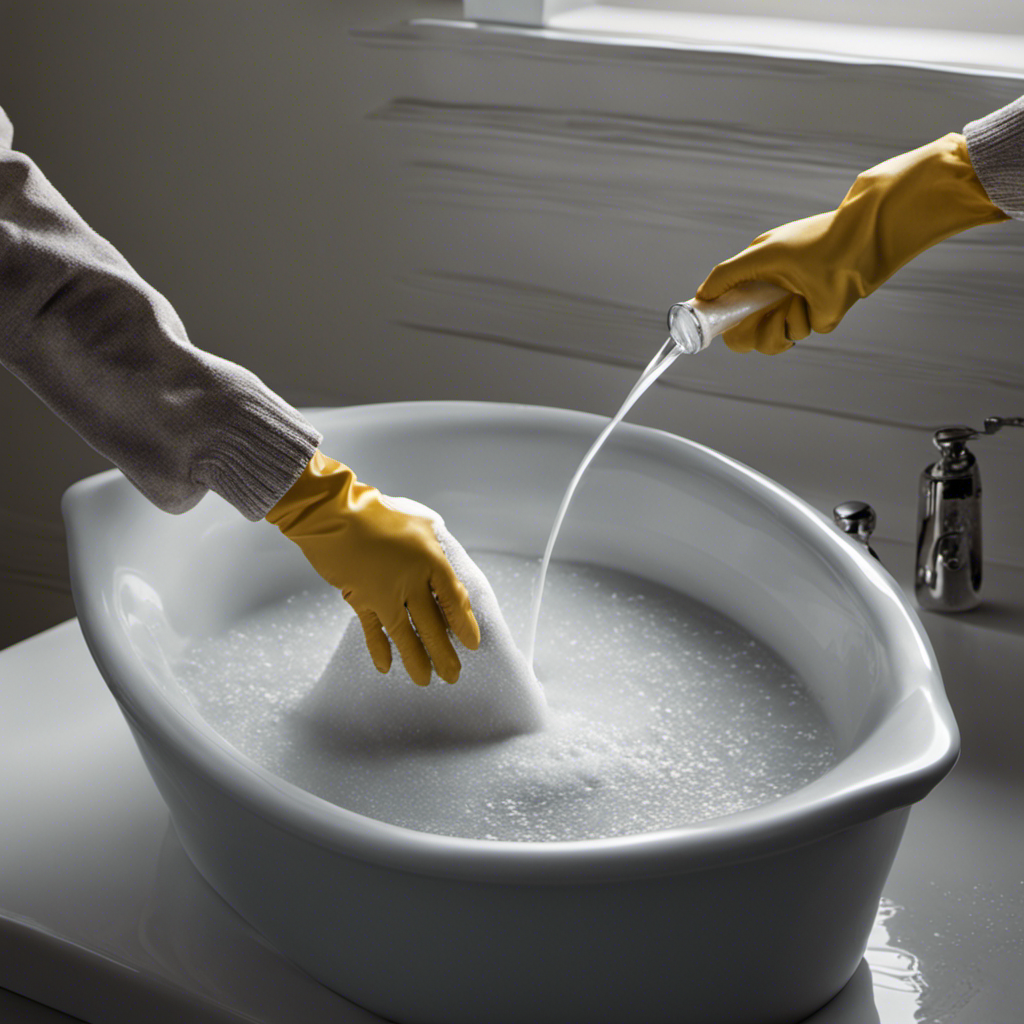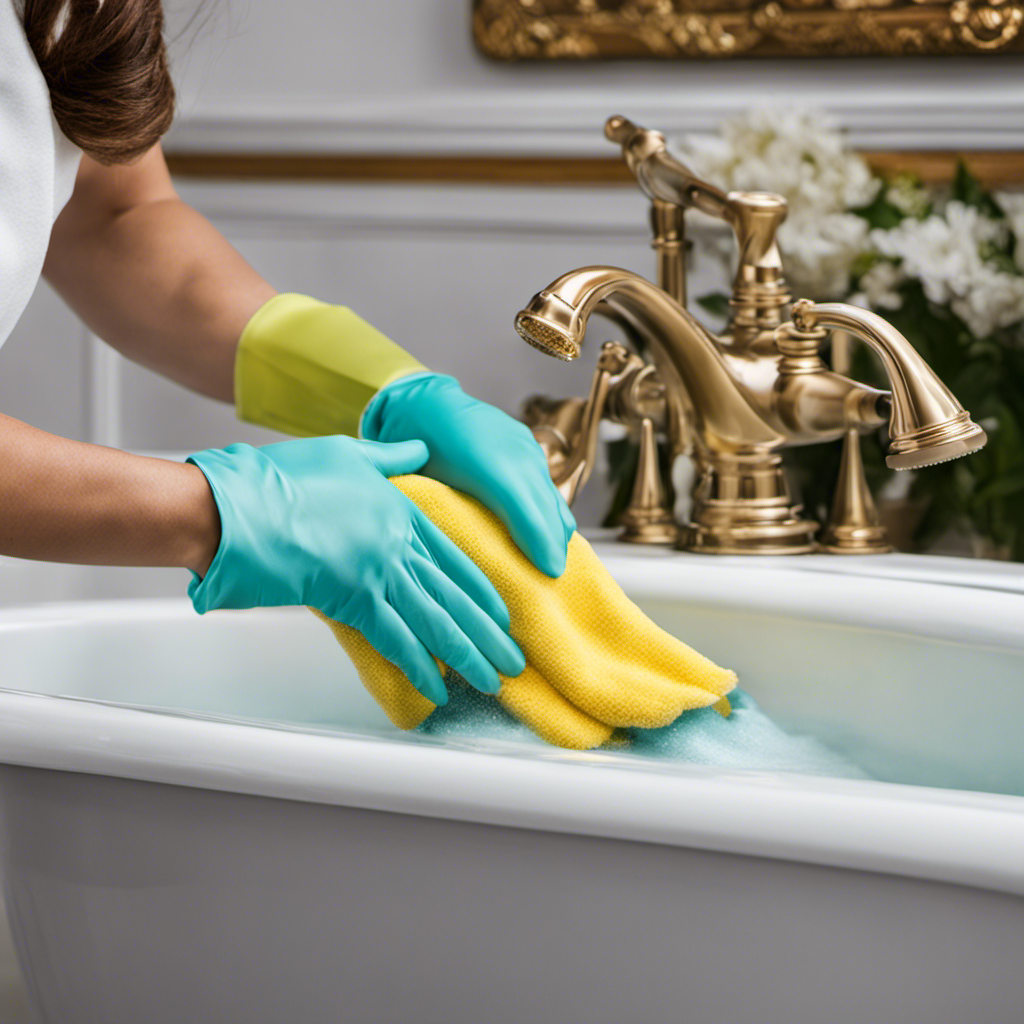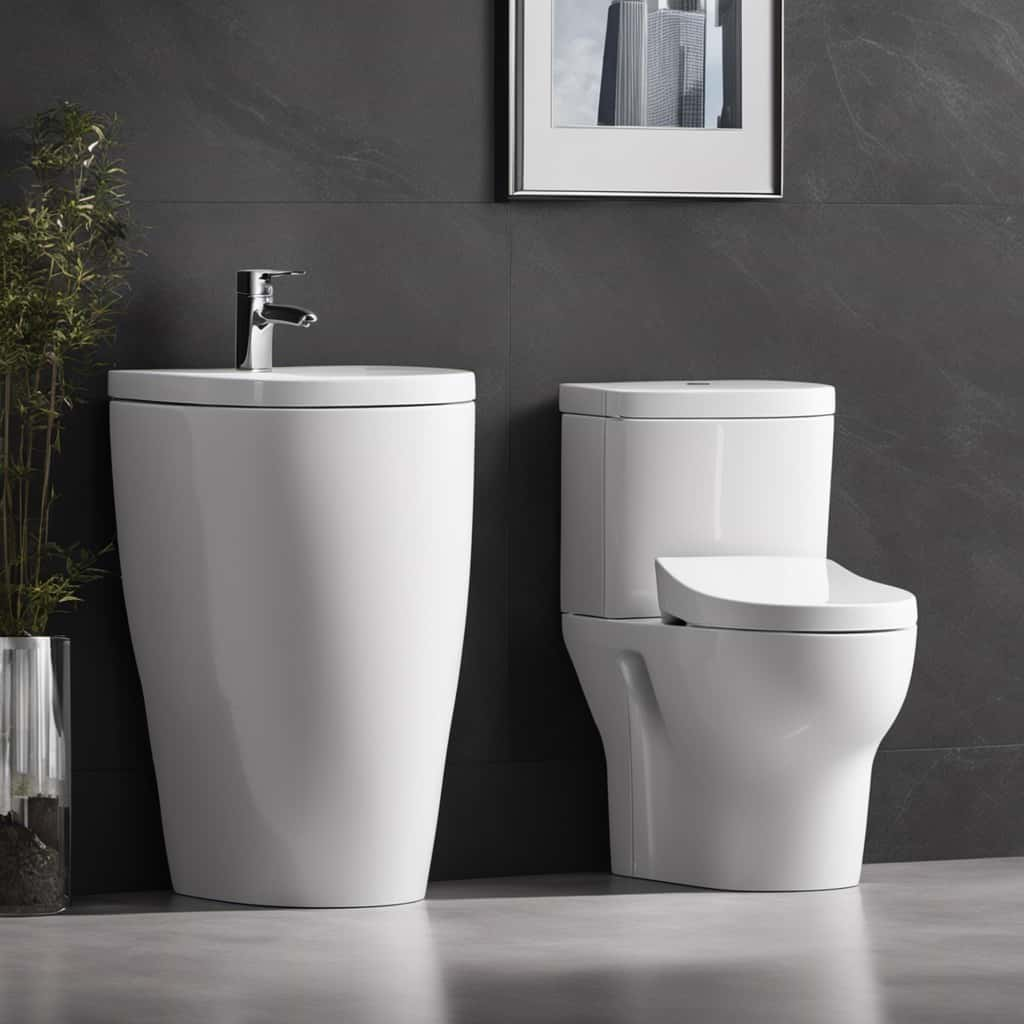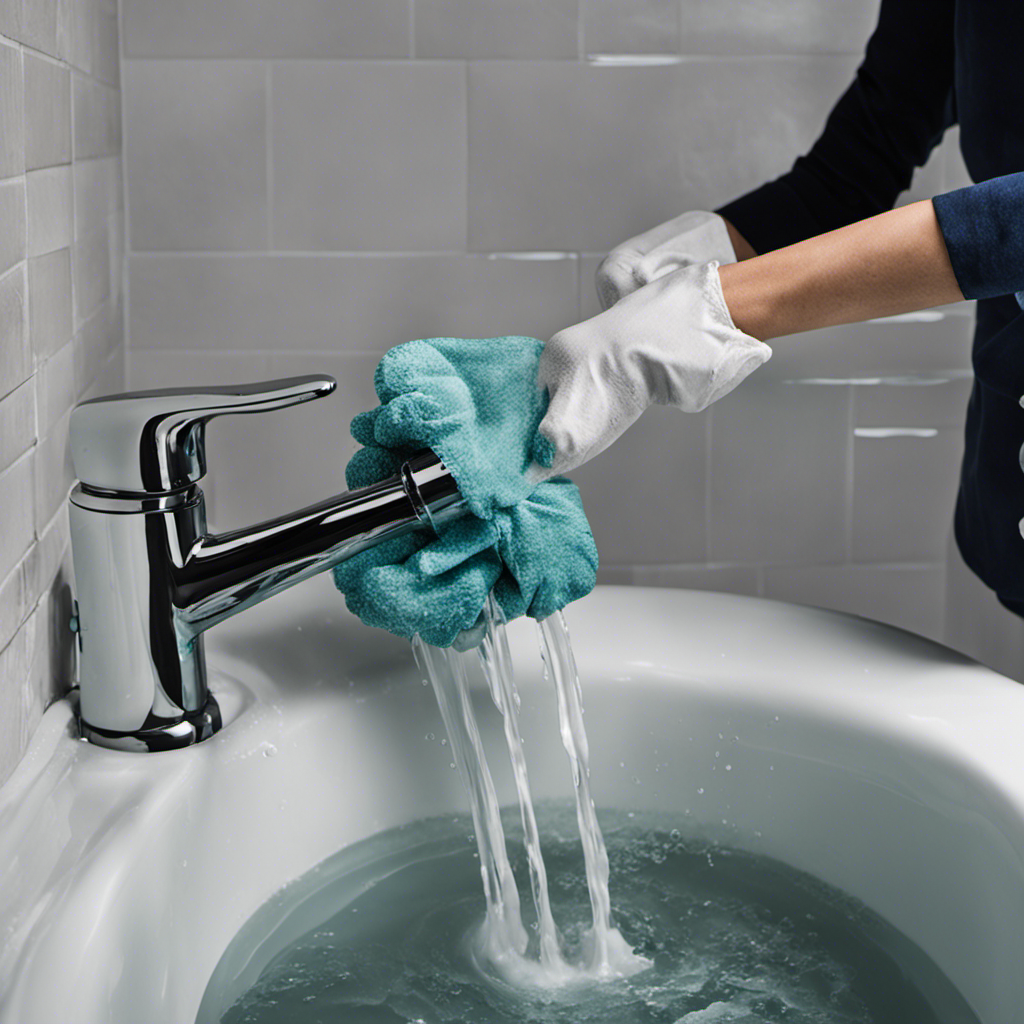So, you’ve found yourself standing in ankle-deep water while taking a shower, thanks to a clogged bathtub drain. Don’t panic just yet! In this article, we’ll guide you through the steps to naturally unclog your drain and get the water flowing freely again.
No need for harsh chemicals or expensive plumbers – with a few simple ingredients and techniques, you’ll be able to tackle this pesky problem on your own.
Get ready to say goodbye to standing water and hello to a smoothly running drain!
Key Takeaways
- Accumulation of hair and soap scum is a common cause of bathtub drain clogs.
- Gurgling sounds or unpleasant odors can indicate a clog in the bathtub drain.
- Assess the severity of the clog by feeling for resistance when plunging.
- Natural remedies like baking soda, vinegar, and hot water can be effective in unclogging bathtub drains.
Understanding the Causes of Bathtub Drain Clogs
Understanding the causes of bathtub drain clogs can help you prevent future blockages. By identifying the reasons behind recurring clogs, you can take the necessary steps to keep your drain functioning smoothly.
One common cause of drain clogs is the accumulation of hair and soap scum. As these substances build up over time, they can create a blockage that restricts water flow.
Another common culprit is the accumulation of foreign objects, such as small toys or jewelry, which can inadvertently make their way into the drain. Additionally, mineral deposits can form inside the pipes, leading to clogs.
It is important to be aware of common signs of a drain clog, such as slow drainage, gurgling sounds, or unpleasant odors. By recognizing these signs and understanding the causes, you can prevent future clogs and keep your bathtub drain clear.
Assessing the Severity of the Clog
To determine how bad the clog is, feel for any resistance when plunging. Evaluating the blockage is an important step in deciding which DIY drain cleaning methods to use.
Start by using a plunger to try and loosen the clog. If you feel little to no resistance, the blockage may be minor and can likely be cleared with simple methods. However, if you encounter significant resistance, the clog may be more severe and require additional steps.
In this case, you can try using a drain snake or a mixture of baking soda and vinegar to break down the blockage. If these methods don’t work, it may be necessary to call a professional plumber for further assistance.
Remember to always proceed with caution and follow safety guidelines when attempting to unclog a drain.
Gathering Natural Ingredients for Unclogging
When gathering natural ingredients for unclogging, you can easily find items such as baking soda and vinegar in your pantry. These common household items are effective in clearing out clogs in your bathtub drain, without the need for harsh chemicals.
Here is a step-by-step guide on how to create a DIY solution using these natural remedies:
- First, grab a box of baking soda and a bottle of vinegar from your pantry.
- Next, pour about half a cup of baking soda directly into the clogged drain.
- Then, slowly pour a cup of vinegar into the drain.
- Watch as the mixture fizzes and bubbles, working its way through the clog.
- After a few minutes, flush the drain with hot water to remove any remaining residue.
- If the clog persists, you can repeat the process or try using a plunger to dislodge the blockage.
Using Baking Soda and Vinegar Method
Using the baking soda and vinegar method is an effective way to clear clogs in your bathroom. This natural and chemical-free method can help unclog your bathtub drain, even if there is standing water. Here’s how you can do it step-by-step:
-
Start by pouring half a cup of baking soda down the drain. Baking soda is known for its benefits in breaking down grease and grime, making it easier to remove clogs.
-
Follow it up with a cup of vinegar. Vinegar is highly effective in dissolving tough clogs and eliminating odors.
-
Immediately cover the drain with a plug or cloth to trap the fizzing reaction between the baking soda and vinegar inside the drain. This reaction helps to loosen the clog.
-
Leave the mixture to work its magic for about 30 minutes. During this time, the fizzing action will help break down the clog.
-
After 30 minutes, remove the plug or cloth and flush the drain with hot water. This will help to wash away any remaining debris.
Employing the Power of Boiling Water
When it comes to unclogging drains, boiling water can be a highly effective method. Boiling water helps to break down and dissolve stubborn clogs, allowing water to flow freely again.
However, it is important to take certain safety precautions when using this method, such as wearing protective gloves and eyewear, and ensuring that the boiling water is carefully poured to avoid splashing or burns.
If you prefer not to use boiling water, there are alternative methods available that can also help to unclog drains effectively.
Boiling Water Effectiveness
To effectively unclog your bathtub drain with standing water naturally, you can try pouring boiling water down the drain. Boiling water is a simple yet powerful tool that can help break up and dissolve clogs, allowing the water to flow freely again.
Here are some key points to keep in mind when using boiling water for this task:
-
Boiling water temperature: Make sure the water is truly boiling, reaching a temperature of at least 212°F (100°C). The high temperature helps to melt away grease, soap scum, and other debris that may be causing the clog.
-
Boiling water safety precautions: Handle boiling water with care to avoid burns. Use oven mitts or heat-resistant gloves when pouring the water into the drain. Be cautious not to splash the boiling water onto yourself or any surrounding surfaces.
Safety Precautions When Boiling
Be careful not to burn yourself or spill the boiling water as you pour it into the drain. Safety precautions are essential when working with boiling water to avoid accidents and injuries. To ensure your safety, follow these steps:
-
Choose a suitable container: Use a heat-resistant container, like a kettle or a pot, to boil the water. Make sure it has a spout or handle for easy pouring.
-
Boiling water temperature: Bring the water to a vigorous boil. The ideal temperature is around 212°F (100°C). Use a kitchen thermometer to ensure accuracy.
-
Proper boiling technique: Allow the water to boil for a few minutes to ensure thorough heating. This will help to kill any bacteria or germs present in the water.
-
Pouring into the drain: Slowly and carefully pour the boiling water into the drain. Aim for the center of the drain opening to ensure maximum effectiveness.
Alternatives to Boiling Water
There are other options available if you want to avoid boiling water to unclog a drain. Here are some alternative solutions that are not only effective but also eco-friendly:
-
Baking Soda and Vinegar: Mix equal parts of baking soda and vinegar to create a foaming reaction. Pour this mixture down the drain and let it sit for about 30 minutes. Then, flush it with hot water to clear the clog.
-
Salt and Hot Water: Dissolve a cup of salt in a pot of hot water. Pour it down the drain and let it sit for a few hours. The salt will help break down the clog, and hot water will flush it away.
-
Wire Hanger: Straighten out a wire hanger and bend one end into a hook shape. Insert it into the drain and start fishing out the clog. Be gentle to avoid damaging the pipes.
These alternative solutions provide effective ways to unclog your drain without using boiling water, while also being environmentally friendly.
Applying Salt and Hot Water Technique
Pour some hot water mixed with salt down the clogged bathtub drain. This technique is effective in unclogging the drain by breaking down the debris and allowing it to flush away.
Start by boiling a pot of water and adding a generous amount of salt to it. The salt concentration helps to dissolve any grease or grime that may be causing the clog. Ensure that the hot water temperature is as high as possible without damaging your pipes.
Carefully pour the saltwater mixture down the drain, making sure it reaches the clog. Let it sit for about 15 minutes to allow the salt to work its magic.
Afterward, proceed to the next step: utilizing a plunger to remove the clog.
Utilizing a Plunger to Remove the Clog
When it comes to unclogging a drain, one of the most effective techniques is utilizing a plunger. This tried and true method uses the power of suction to dislodge and remove the clog.
In addition to discussing the effectiveness of the plunger technique, this discussion will also explore alternative methods for unclogging drains. This will provide you with a range of options to tackle the problem.
Plunger Technique Effectiveness
Using a plunger is a highly effective technique for unclogging a bathtub drain with standing water. The benefits of using a plunger include its simplicity, affordability, and ability to create strong suction.
To unclog your drain using a plunger, follow these steps:
- Start by filling the bathtub with enough water to cover the plunger head.
- Position the plunger directly over the drain, ensuring a tight seal is created.
- Apply downward pressure on the plunger handle, then pull up forcefully to create suction.
- Repeat the plunging motion several times, gradually increasing the intensity.
- After a few attempts, release the plunger and check if the water begins to drain.
- If the water starts to drain, continue plunging until it fully clears.
- If the clog persists, you may need to try alternative techniques or seek professional help.
Alternative Unclogging Methods?
If the plunger technique does not work, you can try other methods to clear a clogged bathtub drain.
There are a few unclogging hacks you can try that are also eco-friendly drain solutions. First, mix together equal parts baking soda and vinegar and pour it down the drain. Let it sit for about 30 minutes, then flush it with hot water. This combination can help break down the clog and remove any residue in the pipes.
Another method is using a mixture of salt and baking soda. Combine half a cup of each and pour it down the drain. Let it sit for a few hours and then flush with hot water. These natural remedies can be effective in unclogging your bathtub drain.
However, if these methods don’t work, you can move on to trying a wire hanger or drain snake to remove the clog.
Trying a Wire Hanger or Drain Snake
You can try a wire hanger or drain snake to unclog a bathtub drain with standing water naturally. Here’s how you can approach it:
-
Wire hanger alternatives: If you don’t have a wire hanger, you can use a straightened metal coat hanger or a long, flexible plastic rod.
-
Straightened metal coat hanger: Bend one end into a hook shape to extract debris from the drain.
-
Long, flexible plastic rod: Insert the rod into the drain and rotate it to break up the clog.
-
Drain snake effectiveness: A drain snake is highly effective in clearing stubborn clogs.
-
Insert the drain snake into the drain and turn the handle to extend the cable.
-
Rotate the cable while pushing it further into the drain to break up the clog.
-
Once the clog is loosened, retract the cable and flush the drain with hot water.
Remember to exercise caution and avoid using excessive force to prevent damaging the pipes.
Using Enzyme Cleaners for Stubborn Clogs
When it comes to dealing with stubborn clogs, enzyme cleaners can be highly effective. These cleaners work by breaking down organic matter, such as hair and grease, which are often the main culprits behind clogs.
Not only are enzyme cleaners effective, but they also offer a natural alternative to harsh chemicals that can be harmful to both you and the environment.
To achieve optimal results with enzyme cleaners, it’s important to follow a few tips. One tip is to use the right amount of product. Using too little may not be effective, while using too much may be wasteful.
Another tip is to allow enough time for the enzymes to work their magic. Enzyme cleaners typically require some time to break down the clog, so be patient and give them enough time to do their job.
Effectiveness of Enzyme Cleaners
Enzyme cleaners can be effective in unclogging bathtub drains with standing water. When you have a stubborn clog that won’t budge, consider using enzyme cleaners to break down the organic matter causing the blockage. Here’s how they work:
- Enzymes in the cleaner target and break down the organic materials, such as hair and soap scum, in the drain.
- As the enzymes work, they create a foaming action that helps to dislodge the clog.
- The cleaner is left to sit in the drain for a specified amount of time, allowing the enzymes to do their job effectively.
To enhance the effectiveness of the enzyme cleaner, you can also try:
- Pouring a mixture of vinegar and hot water down the drain before using the cleaner. The vinegar’s acidity helps to dissolve mineral deposits, while hot water helps to loosen the clog.
Natural Alternative to Chemicals
Using natural alternatives instead of chemicals can be a safer and more environmentally friendly way to clean your drains. When it comes to unclogging your bathtub drain with standing water, there are several natural remedies and eco-friendly solutions you can try. Here is a step-by-step guide on how to do it:
- Start by pouring half a cup of baking soda down the drain.
- Follow it up with half a cup of vinegar.
- Cover the drain with a plug or cloth to trap the fizzing reaction.
- Let it sit for about 30 minutes.
- Boil a kettle of hot water and carefully pour it down the drain to flush away the clog.
- If the clog persists, repeat the process or try using a plumbing snake to remove any remaining debris.
Tips for Optimal Results
For the best results, make sure to carefully cover the drain with a plug or cloth to trap the fizzing reaction. This step is crucial in order to fully harness the power of natural remedies and eco-friendly solutions.
Here are some tips to ensure optimal results:
- Use a natural drain cleaner made of baking soda and vinegar:
- Start by pouring half a cup of baking soda down the drain.
- Follow it with a cup of vinegar.
- Immediately cover the drain to prevent the mixture from escaping.
Allow the solution to fizz and work its magic:
- The combination of baking soda and vinegar creates a foaming reaction that helps break down the clog.
- Let it sit for about 30 minutes to fully dissolve the blockage.
Finally, flush the drain with hot water to wash away any remaining residue.
Preventive Measures to Avoid Future Clogs
To avoid future clogs, you should regularly clean your bathtub drain and use a hair catcher to prevent hair from going down the drain. These simple preventive measures can help maintain the efficiency of your drain system and save you from the hassle of dealing with clogs in the future.
Here are some eco-friendly solutions and DIY maintenance tips to keep your bathtub drain clog-free:
-
Regular Cleaning: Use a drain cleaning solution or a mixture of vinegar and baking soda to flush out any debris or buildup in your drain. This will help prevent clogs and keep your drain smelling fresh.
-
Hair Catcher: Invest in a hair catcher that fits over your drain to catch any loose hair before it goes down the drain. This is a simple and effective way to prevent hair clogs.
-
Monthly Maintenance: Once a month, pour boiling water down the drain to flush out any accumulated grease or soap scum. This will keep your drain clear and prevent future clogs.
Frequently Asked Questions
Can I Use Regular Table Salt for the Salt and Hot Water Technique?
Yes, you can use regular table salt for the salt and hot water technique. It is a natural and cost-effective method for unclogging a bathtub drain. However, it may not be as effective as other methods specifically designed for unclogging drains.
How Long Should I Let the Baking Soda and Vinegar Mixture Sit Before Flushing With Boiling Water?
Let the baking soda and vinegar mixture sit for at least 30 minutes to allow the reaction to break down the clog. Then, flush it with boiling water to maximize the effectiveness.
Are Enzyme Cleaners Safe to Use in All Types of Bathtubs?
Are enzyme cleaners safe for all tubs? Discover the effectiveness of enzyme cleaners and natural alternatives. Learn how to unclog a bathtub drain with standing water using a step-by-step, technical approach.
Can I Use a Plunger on a Bathtub Drain With Standing Water?
Yes, you can use a plunger on a bathtub drain with standing water. A plunger is effective at creating pressure to dislodge clogs. If it doesn’t work, there are alternative methods to unclog the drain.
Are There Any Risks or Precautions I Should Be Aware of When Using a Wire Hanger or Drain Snake?
When using a wire hanger or drain snake to unclog a bathtub drain with standing water, it is important to take precautions. Wear gloves to protect your hands and be careful not to damage the pipes.
Conclusion
In conclusion, you now have the knowledge and tools to tackle that stubborn bathtub drain clog naturally.
By understanding the causes and severity of the clog, gathering the right ingredients, and following the step-by-step methods such as using baking soda and vinegar or employing the power of boiling water, you can unclog your drain effectively.
Don’t forget to try the plunger, wire hanger or drain snake if needed, and consider using enzyme cleaners for those stubborn clogs.
Remember, these preventive measures will help you avoid future clogs and keep your bathtub drain flowing smoothly.
So, roll up your sleeves and get ready to tackle that clog!










